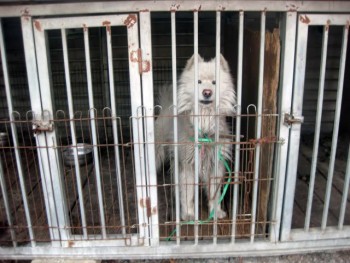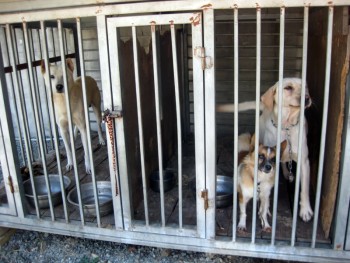A friendly 10-year-old spaniel named Sunny is admitted to a shelter. Sunny has sarcoptic mange, but the shelter has no isolation room. A foster family is available, but the family has two young children and a dog who would be at risk. What to do with Sunny?
It’s the third and final day of the shelter workshop in October, and Paul Littlefair has already left the country. His RSPCA colleagues Miranda Luck and Kasia Kilvington are leading the workshop at Konkuk University in Seoul, and they present Sunny’s story and seven other scenarios to 15 or 20 Koreans involved in some way in the management of homeless animals. Most work in municipal shelters.
There was a bigger turnout on the first day of the event, I learn during the break, and I’ve missed some important people: Dr. Myung, the veterinarian in Gwangju who is developing guidelines for shelters; Dr. Woo from the Korean Veterinary Medical Association; numerous shelter managers. I speak briefly with a vet from the quarantine agency, but she tells me she has no authority to speak publicly.
Yesterday the group travelled to a town north of Seoul, where a well-known animal control organization welcomed the workshop participants and showed them the new exercise pen.
“They opened their doors,” Kilvington says in response to my questions about Korea’s animal control system and stories I’ve heard from local animal advocates. Kilvington says the municipal shelter managers she’s talked to are very concerned about adoption rates and very open to making changes; they don’t just kill automatically after 10 days as the law permits. She praises their efforts to use the Internet to promote adoptions and reunite lost animals with their families. She acknowledges, however, that the RSPCA only has a small window into the situation.
In the morning the focus is on problem solving, disease control and how to enrich environments; adoption fees and sterilization policies also come up. (“If they question the price,” Luck says, “I would question their ability to care for the animal for the rest of its life.”) Luck used to run an RSPCA shelter and she tells the group she improved conditions significantly by building up the shelter’s volunteer program.
In the afternoon they discuss the scenarios. Participants are seated around three tables; their task is to look at the animals, read their stories, and decide their fates. Luck and Kilvington have shown me the English version of the workbook the participants are looking at, but at times I have to strain to hear the soft-spoken interpreter.
“Just as an aid to help with decision-making,” Luck says, “these are based on true stories—situations I’ve had to deal with myself.”
Luck asks the workshop participants which animal they’ve had the most discussion about and someone says Crusty.
Crusty is a large dog who was injured in a car accident—the accident got news coverage because a celebrity was driving the car. On the screen I can see that Crusty is a reddish colour and I can’t see one of her eyes; I think it’s bandaged. Both her back feet are either bandaged or in casts. Crusty is poorly socialized, she’s not housetrained, she has a skin disease, and she may be pregnant.
The first sub-group says the shelter should do its best to find a home for Crusty, and homes for all her puppies if she turns out to be pregnant.
When the spokesman for the next group takes his turn, his answer (“he would take care of the pregnancy condition”) requires clarification. It turns out he would provide special care for Crusty and find homes for her and all the puppies. And he would fully use the media to get them adopted.
“How important was the media in influencing your decision?” Luck asks.
“Would it be the same if Crusty hadn’t been hit by a celebrity?” Kilvington asks.
Yes, he says. His decision would be the same.
The first two groups have persuaded the third, which now intends to use the media to get specialist care for Crusty. Luck says the rescue group that took in the real Crusty never thought of that.
Finally we learn what happened: the rescue had to weigh the pros and cons because Crusty had a condition that was difficult to treat. She also had a nervous temperament, so any babies she had would need special care. On the other hand, Luck says, it was a chance for good media publicity. The rescue decided to treat Crusty and “go for the publicity,” but to have her sterilized without telling the media about the possible pregnancy.
The case did generate a lot of media attention, Luck says, but Crusty has a chronic immune deficiency and is a heavy financial burden. Now she’s a mascot for the organization.
“Maintaining welfare is complicated because she’s not used to humans,” Luck says.
Buggs is a 2-year-old rabbit who is circling in his cage and chewing at the bars from stress. The one available volunteer has construction experience but no animal handling skills. Buggs has to share a cramped room with other animals—including predators such as ferrets—and the room is cluttered with old, broken cages. We see a picture of Buggs chewing on a bar in his cage. He’s a big fat rabbit with floppy ears.
It’s difficult to hear every word, but I get the feeling that most people in the group would ask the volunteer to improve Buggs’ living environment. In real life, Luck’s rescue organization asked the volunteer to clear out the room, sort out the cages and fix those that could be fixed. He helped develop the area to make it habitable for small animals.
“That became his area of expertise,” Luck says.
Next they consider a nameless stray cat. She’s pregnant, she was trapped with great difficulty, and it’s obvious she’s feral. The people who trapped her don’t want her released in the same area. There is space in the shelter to keep her for two days, but after that the shelter is expecting a litter of kittens and will no longer have room.
One participant says the cat should be sent to another shelter; another says the mother cat can take care of her own kittens and the new kittens too; someone else says neuter-release is the only solution. I think there’s disagreement at one table, with all but one person wanting the cat to live.
In real life, the shelter discussed neutering the cat and releasing her back to the same location, but decided against it because the local people didn’t want her there. Releasing her in a different area presented welfare concerns, Luck says. In a new environment the cat might have trouble finding food: who would oversee feeding and medical care if she needed it? If she had been allowed to give birth at the shelter, Luck says, the shelter would have had four, six or eight feral cats to care for. For all these reasons, she said, “it was decided to euthanase.”
One participant says there is a similar problem in Korea—many people don’t want cats in their communities. Luck advises each organization represented at the workshop to decide whether to be a rehoming centre, a sanctuary, or a centre for the rehabilitation of feral kittens.
“It’s hard to do well at all three.”
In the next picture, a blond woman leans over a 4-year-old German shepherd named Rocko. Rocko has three legs—he is still recovering from the amputation, which his family paid for. But his family no longer wants him and he needs help moving around. His recovery will take about three weeks, the shelter is short-staffed, and no one can lift him.
A man gives his opinion in Korean on behalf of the first sub-group, and the interpreter stumbles on the word “euthanase.”
“He doesn’t hesitate to euth …he doesn’t hesitate to kill the dog.”
According to Korean law, the group spokesman explains, the dog only has to be held for 10 days. Keeping him longer is a waste of money because his chances of adoption are very poor.
We learn later that Luck is the woman in the picture.
“That’s actually me with short hair nursing Rocko,” she says.
Luck tells us what happened: the shelter decided to contact Rocko’s original family to see if they would consider taking him back. The answer was no, definitely not, because he was extremely dog-aggressive. The reason Rocko lost his leg, we find out, is that he got it caught in a fence while attacking another dog. Luck’s organization didn’t know that until its staff had spent 10 days rehabilitating Rocko.
“Consequently, this dog was euthanased,” she says.
The day is coming to an end, and the group won’t have time to discuss every animal. The workshop participants have to decide on one more. They want to talk about Sunny—an elderly dog who loves everyone. She’s housetrained. She’s not very big. But there is nowhere to isolate her, Luck says, and sarcoptic mange can spread to humans from other animals.
My notes are patchy here, but I think someone may have suggested building a portable structure for Sunny. Luck’s organization, however, decided against putting Sunny in the back of someone’s office or in an administration area because that “wouldn’t meet her welfare needs.”
Sunny’s story was a lesson in the value of collaboration, Luck tells us. Her organization spoke with another rescue organization and asked about other available foster homes. Even though rescue groups often guard good foster parents—not wanting to lose them to “the competition,” she says—this one referred Luck’s shelter to a single person with no children or other animals. As a result Sunny was nursed back to health, came back to the shelter and was eventually rehomed.
If there were no other foster home, someone asks, would you euthanase Sunny? (By now the word comes easily to the interpreter.)
“Yes, potentially,” Luck says, explaining that Sunny needs nursing and human companionship. “So if she wasn’t going to get time, attention and care then I would consider euthanasia, yes.”
The RSPCA visitors thank their hosts, who have been so caring and attentive.
“The coffee is always waiting. We don’t want to go anywhere other than Korea.”
In three days, the workshop participants have had a lot to take in. Kilvington is hoping they will take away the need for mission statements, written policies and written routines—and, she adds, the message that good welfare doesn’t necessarily mean keeping an animal in a shelter indefinitely.

Written by Eileen Cahill. Photos by Sofia Dyachkova.
See also Part One of this article, RSPCA in Korea: a surprise meeting.

